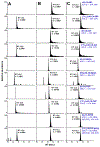Multi-DNA Adduct and Abasic Site Quantitation In Vivo by Nano-Liquid Chromatography/High-Resolution Orbitrap Tandem Mass Spectrometry: Methodology for Biomonitoring Colorectal DNA Damage
- PMID: 36066083
- PMCID: PMC9665354
- DOI: 10.1021/acs.chemrestox.2c00177
Multi-DNA Adduct and Abasic Site Quantitation In Vivo by Nano-Liquid Chromatography/High-Resolution Orbitrap Tandem Mass Spectrometry: Methodology for Biomonitoring Colorectal DNA Damage
Abstract
Epidemiological and mechanistic studies suggest that processed and red meat consumption and tobacco smoking are associated with colorectal cancer (CRC) risk. Several classes of carcinogens, including N-nitroso compounds (NOCs) in processed meats and heterocyclic aromatic amines (HAAs) and polycyclic aromatic hydrocarbons (PAHs) in grilled meats and tobacco smoke, undergo metabolism to reactive intermediates that may form mutation-inducing DNA adducts in the colorectum. Heme iron in red meat may contribute to oxidative DNA damage and endogenous NOC formation. However, the chemicals involved in colorectal DNA damage and the paradigms of CRC etiology remain unproven. There is a critical need to establish physicochemical methods for identifying and quantitating DNA damage induced by genotoxicants in the human colorectum. We established robust nano-liquid chromatography/high-resolution accurate mass Orbitrap tandem mass spectrometry (LC/HRAMS2) methods to measure DNA adducts of nine meat and tobacco-associated carcinogens and lipid peroxidation products in the liver, colon, and rectum of carcinogen-treated rats employing fresh-frozen and formalin-fixed paraffin-embedded (FFPE) tissues. Some NOCs form O6-carboxymethyl-2'-deoxyguanosine, O6-methyl-2'-deoxyguanosine, and unstable quaternary N-linked purine/pyrimidine adducts, which generate apurinic/apyrimidinic (AP) sites. AP sites were quantitated following derivatization with O-(pyridin-3-yl-methyl)hydroxylamine. DNA adduct quantitation was conducted with stable isotope-labeled internal standards, and method performance was validated for accuracy and reproducibility. Limits of quantitation ranged from 0.1 to 1.1 adducts per 108 bases using 3 μg of DNA. Adduct formation in animals ranged from ∼1 in 108 to ∼1 in 105 bases, occurring at comparable levels in fresh-frozen and FFPE specimens for most adducts. AP sites increased by 25- to 75-fold in the colorectum and liver, respectively. Endogenous lipid peroxide-derived 3-(2-deoxy-β-d-erythro-pentofuranosyl)pyrimido[1,2-α]purin-10(3H)-one (M1dG) and 6-oxo-M1dG adduct levels were not increased by carcinogen dosing but increased in FFPE tissues. Human biomonitoring studies can implement LC/HRAMS2 assays for DNA adducts and AP sites outlined in this work to advance our understanding of CRC etiology.
Conflict of interest statement
Figures







References
-
- Armstrong B; Doll R Environmental Factors and Cancer Incidence and Mortality in Different Countries, with Special Reference to Dietary Practices. Int. J. Cancer 1975, 15, 617–631. - PubMed
-
- Bouvard V; Loomis D; Guyton KZ; Grosse Y; Ghissassi FE; Benbrahim-Tallaa L; Guha N; Mattock H; Straif K Carcinogenicity of Consumption of Red and Processed Meat. Lancet Oncol. 2015, 16, 1599–1600. - PubMed
-
- Giovannucci E An Updated Review of the Epidemiological Evidence That Cigarette Smoking Increases Risk of Colorectal Cancer. Cancer Epidemiol. Biomarkers Prev 2001, 10, 725–731. - PubMed
Publication types
MeSH terms
Substances
Grants and funding
LinkOut - more resources
Full Text Sources
Medical

